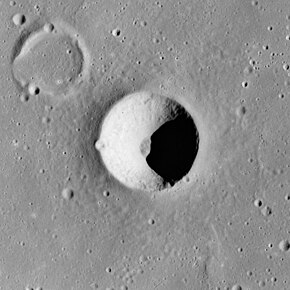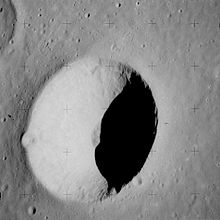
Apollo 15 image | |
| Coordinates | 29°54′N 41°36′W / 29.9°N 41.6°W [1] |
|---|---|
| Diameter | 9.55 [1] km |
| Depth | 2.0 km |
| Colongitude | 42° at sunrise |
| Eponym | Anders J. Ångström [1] |


Ångström is a small lunar impact crater located on the border between Oceanus Procellarum to the west and Mare Imbrium to the east. To the south is a formation of mountains rising out of the mare named the Montes Harbinger. To the east are some wrinkle ridges named the Dorsum Bucher and Dorsa Argand. This crater is bowl-shaped, with a circular rim and inner walls that slope down to the small central floor. It has a higher albedo than the surrounding maria. [2] The crater halo is radar dark, indicating a lack of larger blocks among the fine ejecta. [3]
Ångström crater is named after Anders Jonas Ångström, [1] a Swedish physicist and one of the founders of the science of spectroscopy.
Satellite craters
By convention these features are identified on lunar maps by placing the letter on the side of the crater midpoint that is closest to Ångström. [2]
| Ångström | Latitude | Longitude | Diameter |
|---|---|---|---|
| A | 30.9° N | 41.1° W | 6 km |
| B | 31.7° N | 44.1° W | 6 km |
References
- ^ a b c d Blue, Jennifer (July 25, 2007). "Gazetteer of Planetary Nomenclature". USGS. Retrieved 2007-08-05.
- ^ a b Bussey, B.; Spudis, P. (2004). The Clementine Atlas of the Moon. New York: Cambridge University Press. ISBN 978-0-521-81528-4.
- ^ Ghent, Rebecca R.; et al. (February 2005). "Earth-based observations of radar-dark crater haloes on the Moon: Implications for regolith properties". Journal of Geophysical Research. 110 (E2): E02005. Bibcode: 2005JGRE..110.2005G. doi: 10.1029/2004JE002366. E02005.
Sources
- Andersson, L. E.; Whitaker, E. A. (1982). NASA Catalogue of Lunar Nomenclature. NASA RP-1097.
- Cocks, Elijah E.; Cocks, Josiah C. (1995). Who's Who on the Moon: A Biographical Dictionary of Lunar Nomenclature. Tudor Publishers. ISBN 978-0-936389-27-1.
- McDowell, Jonathan (July 15, 2007). "Lunar Nomenclature". Jonathan's Space Report. Retrieved 2007-10-24.
- Menzel, D. H.; Minnaert, M.; Levin, B.; Dollfus, A.; Bell, B. (1971). "Report on Lunar Nomenclature by the Working Group of Commission 17 of the IAU". Space Science Reviews. 12 (2): 136–186. Bibcode: 1971SSRv...12..136M. doi: 10.1007/BF00171763. S2CID 122125855.
- Moore, Patrick (2001). On the Moon. Sterling Publishing Co. ISBN 978-0-304-35469-6.
- Price, Fred W. (1988). The Moon Observer's Handbook. Cambridge University Press. ISBN 978-0-521-33500-3.
- Rükl, Antonín (1990). Atlas of the Moon. Kalmbach Books. ISBN 978-0-913135-17-4.
- Webb, Rev. T. W. (1962). Celestial Objects for Common Telescopes (6th revised ed.). Dover. ISBN 978-0-486-20917-3.
- Whitaker, Ewen A. (1999). Mapping and Naming the Moon. Cambridge University Press. ISBN 978-0-521-62248-6.
- Wlasuk, Peter T. (2000). Observing the Moon. Springer. ISBN 978-1-85233-193-1.
External links
-
 Media related to
Angstrom (crater) at Wikimedia Commons
Media related to
Angstrom (crater) at Wikimedia Commons - LTO-39A2 Angstrom — detailed USGS topographic map of crater and vicinity

Apollo 15 image | |
| Coordinates | 29°54′N 41°36′W / 29.9°N 41.6°W [1] |
|---|---|
| Diameter | 9.55 [1] km |
| Depth | 2.0 km |
| Colongitude | 42° at sunrise |
| Eponym | Anders J. Ångström [1] |


Ångström is a small lunar impact crater located on the border between Oceanus Procellarum to the west and Mare Imbrium to the east. To the south is a formation of mountains rising out of the mare named the Montes Harbinger. To the east are some wrinkle ridges named the Dorsum Bucher and Dorsa Argand. This crater is bowl-shaped, with a circular rim and inner walls that slope down to the small central floor. It has a higher albedo than the surrounding maria. [2] The crater halo is radar dark, indicating a lack of larger blocks among the fine ejecta. [3]
Ångström crater is named after Anders Jonas Ångström, [1] a Swedish physicist and one of the founders of the science of spectroscopy.
Satellite craters
By convention these features are identified on lunar maps by placing the letter on the side of the crater midpoint that is closest to Ångström. [2]
| Ångström | Latitude | Longitude | Diameter |
|---|---|---|---|
| A | 30.9° N | 41.1° W | 6 km |
| B | 31.7° N | 44.1° W | 6 km |
References
- ^ a b c d Blue, Jennifer (July 25, 2007). "Gazetteer of Planetary Nomenclature". USGS. Retrieved 2007-08-05.
- ^ a b Bussey, B.; Spudis, P. (2004). The Clementine Atlas of the Moon. New York: Cambridge University Press. ISBN 978-0-521-81528-4.
- ^ Ghent, Rebecca R.; et al. (February 2005). "Earth-based observations of radar-dark crater haloes on the Moon: Implications for regolith properties". Journal of Geophysical Research. 110 (E2): E02005. Bibcode: 2005JGRE..110.2005G. doi: 10.1029/2004JE002366. E02005.
Sources
- Andersson, L. E.; Whitaker, E. A. (1982). NASA Catalogue of Lunar Nomenclature. NASA RP-1097.
- Cocks, Elijah E.; Cocks, Josiah C. (1995). Who's Who on the Moon: A Biographical Dictionary of Lunar Nomenclature. Tudor Publishers. ISBN 978-0-936389-27-1.
- McDowell, Jonathan (July 15, 2007). "Lunar Nomenclature". Jonathan's Space Report. Retrieved 2007-10-24.
- Menzel, D. H.; Minnaert, M.; Levin, B.; Dollfus, A.; Bell, B. (1971). "Report on Lunar Nomenclature by the Working Group of Commission 17 of the IAU". Space Science Reviews. 12 (2): 136–186. Bibcode: 1971SSRv...12..136M. doi: 10.1007/BF00171763. S2CID 122125855.
- Moore, Patrick (2001). On the Moon. Sterling Publishing Co. ISBN 978-0-304-35469-6.
- Price, Fred W. (1988). The Moon Observer's Handbook. Cambridge University Press. ISBN 978-0-521-33500-3.
- Rükl, Antonín (1990). Atlas of the Moon. Kalmbach Books. ISBN 978-0-913135-17-4.
- Webb, Rev. T. W. (1962). Celestial Objects for Common Telescopes (6th revised ed.). Dover. ISBN 978-0-486-20917-3.
- Whitaker, Ewen A. (1999). Mapping and Naming the Moon. Cambridge University Press. ISBN 978-0-521-62248-6.
- Wlasuk, Peter T. (2000). Observing the Moon. Springer. ISBN 978-1-85233-193-1.
External links
-
 Media related to
Angstrom (crater) at Wikimedia Commons
Media related to
Angstrom (crater) at Wikimedia Commons - LTO-39A2 Angstrom — detailed USGS topographic map of crater and vicinity
